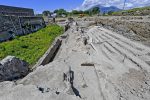 Archaeologists excavating have discovered a row of houses with intact second story balconies. So far four adjacent balconies have been unearthed, plus the remains of railings, tile roofs and even empty amphorae that had been tilted on their sides to dry out in the sun.
Archaeologists excavating have discovered a row of houses with intact second story balconies. So far four adjacent balconies have been unearthed, plus the remains of railings, tile roofs and even empty amphorae that had been tilted on their sides to dry out in the sun.
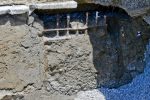 Second floors of buildings are very seldom found in Pompeii because of the way the eruption of Vesuvius struck the city, burying it from above first with a six-hour fall of pumice and ash. The weight of the volcanic material caused roofs and storeys to collapse and suffocated people as they sought shelter. The superheated pyroclastic surges that followed reduced people and buildings to ashes. Herculaneum, on the other hand, was destroyed by
Second floors of buildings are very seldom found in Pompeii because of the way the eruption of Vesuvius struck the city, burying it from above first with a six-hour fall of pumice and ash. The weight of the volcanic material caused roofs and storeys to collapse and suffocated people as they sought shelter. The superheated pyroclastic surges that followed reduced people and buildings to ashes. Herculaneum, on the other hand, was destroyed by 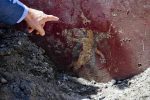 volcanic pyroclasts that flooded the city from bottom to top and then way over the top. They hardened into 20 meters of dense rock, preserving structures and carbonized organic material for 2,000 years.
volcanic pyroclasts that flooded the city from bottom to top and then way over the top. They hardened into 20 meters of dense rock, preserving structures and carbonized organic material for 2,000 years.
The balconies were found in a previously unexcavated section of Regio V of the ancient city known as “the wedge” because of its triangular shape. The excavation in this area has been highly productive, rich with frescoed walls in vivid colors and designs — ochre and pompeiian red, geometrics, animals, florals, winged cupids — but the discovery of a whole alley of balconies preserved in great detail is unique for Pompeii.
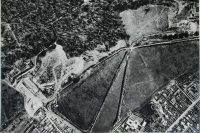
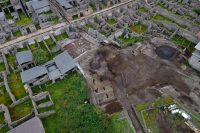
The excavation is ongoing and in the upcoming months more may be found. Meanwhile, the dig team, which is composed of more than 40 experts from architects to archaeologists to archaeobotanists, is exploring the site more thoroughly than ever with the aid of technology like drones, nanocameras and laser scanners. In the course of their work, they’ve uncovered the very 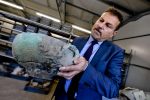 beginnings of Pompeiian archaeology, the excavations of the mid-1700s, which were accomplished by digging one very deep hole and then digging long tunnels radiating out from the central pit. This was not archaeology as the professional discipline dedicated to the pursuit of knowledge and preservation of material culture. It was treasure-hunting, pure and simple, and the archaeological team walking in their footsteps today has found evidence of this in the things they dropped or deliberately left behind because they considered them of little value, including fresco fragments and a large, handsome bronze vessel missing one of its handles.
beginnings of Pompeiian archaeology, the excavations of the mid-1700s, which were accomplished by digging one very deep hole and then digging long tunnels radiating out from the central pit. This was not archaeology as the professional discipline dedicated to the pursuit of knowledge and preservation of material culture. It was treasure-hunting, pure and simple, and the archaeological team walking in their footsteps today has found evidence of this in the things they dropped or deliberately left behind because they considered them of little value, including fresco fragments and a large, handsome bronze vessel missing one of its handles.
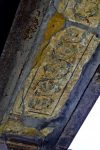 The newly discovered homes and their balconies will be stabilized and added to a new route that will take visitors from the Via di Nola to the Alley of the Silver Wedding, the latter of which takes it name from a luxury villa found on the street. The House of the Silver Wedding is sumptuously appointed, featuring a grand atrium with Corinthian columns 23 feet high, elaborate frescoes in the dining room, mosaics depicting a Roman aqueduct in the private baths, and even rich Pompeiian red frescoes on a cream background covering the entire wall of a small latrine off the kitchen. The villa has been closed for decades but is in the process of being restored and will be reopened to the public as part of the new route. You can get a glimpse of its many wonders in this video tour.
The newly discovered homes and their balconies will be stabilized and added to a new route that will take visitors from the Via di Nola to the Alley of the Silver Wedding, the latter of which takes it name from a luxury villa found on the street. The House of the Silver Wedding is sumptuously appointed, featuring a grand atrium with Corinthian columns 23 feet high, elaborate frescoes in the dining room, mosaics depicting a Roman aqueduct in the private baths, and even rich Pompeiian red frescoes on a cream background covering the entire wall of a small latrine off the kitchen. The villa has been closed for decades but is in the process of being restored and will be reopened to the public as part of the new route. You can get a glimpse of its many wonders in this video tour.